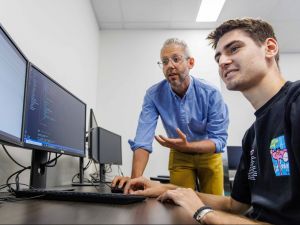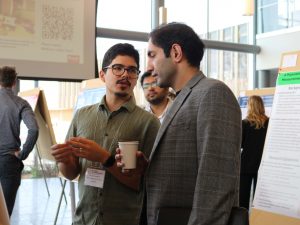 From left, Brock Facilities Manager, Structural Services Bryan Cober holds a community nursing simulation baby while discussing the newly renovated Community Apartment with Nursing Lab Coordinator Kerry Shoalts.
From left, Brock Facilities Manager, Structural Services Bryan Cober holds a community nursing simulation baby while discussing the newly renovated Community Apartment with Nursing Lab Coordinator Kerry Shoalts.The complex medical conditions of people who require nursing care in their home is the focus of Brock University’s newly renovated community apartment in the Nursing Simulation Lab.
Fourth-year Nursing students will now engage in experiential learning by responding to various scenarios in a safe space designed to look and feel like a patient’s home.
“Caring for a patient in their home is very different than caring for someone in a community agency or hospital setting,” says Associate Professor of Nursing Karyn Taplay. “The care is very personal, in their own environment and on their terms.”
The newly constructed community apartment, which includes a separate living/dining room, bedroom, bathroom and stairs, has the capacity to mimic a wide variety of realistic scenarios.

from left, Nursing Assistant Lab Coordinator Isobelle Blake, Faculty of Applied Health Sciences Dean Peter Tiidus, Nursing Associate Professor Karyn Taplay, Nursing Lab Coordinator Kerry Shoalts and Nursing Assistant Lab Coordinator Shelley Wills pose during a visit to Brock University’s newly renovated community apartment.
Taplay, who began designing patient home care scenarios in 2012 after observing a significant gap in the number of students with experience caring for clients in their home, said the new space provides endless teaching and learning possibilities.
“Eight years ago, I noticed that only two to six per cent of students enrolled in the fourth-year Community Health Nursing class were gaining essential home care experience,” says Taplay. “I felt every student should have a first-hand understanding, so I developed two simulation scenarios with elderly individuals — one with a man experiencing grief and another with a woman who required daily dressing changes. This enabled every student to participate.”
To make the empty space more realistic, Taplay and the clinical instructors began to furnish it with second-hand items. Feedback from students was so positive that the Department of Nursing invested in the creation of a community apartment beside the main clinical lab in East Academic 2 as part of the high-tech lab expansion in 2016.
After assessing how the space was being used with Nursing Lab Coordinator Kerry Shoalts and Facilities Manager of Structural Services Bryan Cober in September 2018, an upgrade plan was created to enhance the student experience.
“Our team is comprised of eager problem-solvers,” says Cober. “When Kerry came to us with this out of the ordinary request, we saw it as an exciting opportunity to be creative and really put our skills to use.”
The collaboration was an opportunity for faculty and staff who don’t normally work together to gain an understanding of the academic operations and development of campus facilities.
“As we learned how the students would use the space, we were able to come up with a design to meet a variety needs,” says Cober. “For example, I found it interesting that we were being asked to build stairs into the project. My instinct is this is a trip hazard, but when Kerry explained that is the purpose, I understood it needed to be an important part of the learning environment.”
He adds that the team, which included Brock Carpenter Mike Law and in-house electricians and plumbers, are extremely pleased with the outcome.

From left, Nursing Lab Coordinator Kerry Shoalts and Nursing Associate Professor Karyn Taplay.
“Not only does it look fantastic, but it is an extremely functional space, which includes an observation window in the bedroom to allow for instructor assessment and students to view each other working,” he says.
Individuals who receive nursing care at home often have acute and multifaceted needs. With an increasing amount of care being provided to seniors and individuals of all ages in the home, there will be more career opportunities in community nursing care requiring specialized skills.
“People can often stay in their homes longer if they have the appropriate support, but from a nursing perspective, there are different issues to be aware of,” says Shoalts. “Our students are taught to assess safety, prioritize client’s needs and implement a plan of care including psychomotor skills. The newly renovated community apartment will allow them to collaborate as they learn in a practical and hands-on environment.”
The community apartment will also foster creativity among students and faculty to co-develop scenarios. Since September, Taplay has been working with six fourth-year Nursing students who have a passion for community health nursing to create additional simulations. These include a teenage mom with a premature baby, an individual in an abusive relationship with the abuser present in the home and the registered nurse teaching an unlicensed healthcare provider to correctly insert the patient’s Foley catheter.
“Working alongside our students to give them a voice and co-create new scenarios is very inspiring,” says Taplay. “These latest scenarios will be submitted to a provincial simulation repository for other nursing programs in Ontario to access.”








